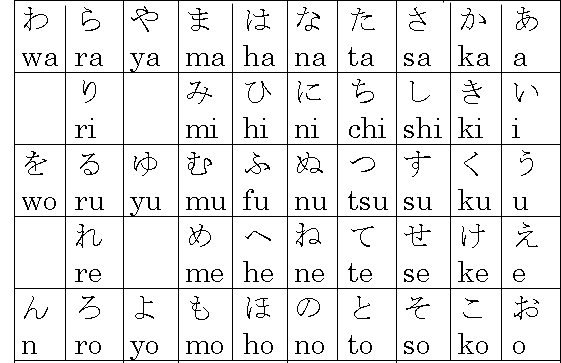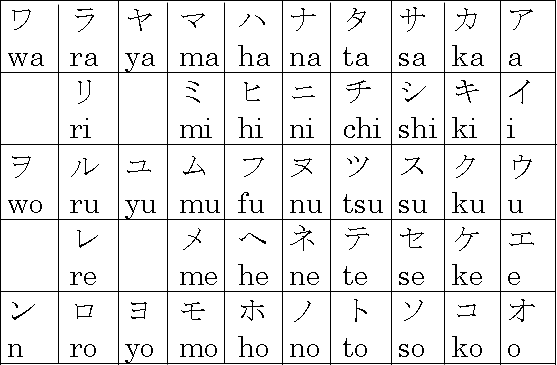

As we think that many viewers have an interest in the Japanese language, the explanation below is fairly detailed. However, for those who are simply trying to find a word, here are the things you have to know.
If you can't find a word which has a syllable ending in
o, such as dojo, try adding a u to the
o, making it doujou.
The same rule applies for words with syllables ending with
u, such as ryu. It will be found under
ryuu.
If the final consonant of a syllable that is not the final syllable
is m, and the following syllable begins with b,
h, p or m it will probably be under n.
For example, sempai, senior, is under
senpai.
If you are looking for a word that begins with g, such as
giri, cut, and cannot find it, try searching for the
same word, but begin with a k, rather than g--i.e.
kiri instead of giri. If the unfound word begins with
d, then begin it with t. If it begins with z,
than try s--if it begins with ji than try shi.
(If the first syllable is zu then it may either be under
su or tsu) If it begins with b or p,
then try with h. (However, if it begins with bu or
pu then try with fu.) NOTE: The process whereby the
k becomes g, t becomes d, s
becomes z, etc. depending on what follows it is called
voicing in linguistics.
Also, keep in mind that those who do not speak the language may mispronounce it--if for example, you are looking for a word with the syllable ban and it's not there, then try bon, etc. Though the word tsuki, thrust or punch, sounds like it is spelled tski, remember that the only final consonant in Japanese is n, and there may be a vowel, probably a u, in there, that you're missing.
Those with an interest in the language can read on to discover the reasons for these conventions.
Firstly, I want to give thanks to Kasumi for his help with this article--his suggestions, based on his linguistics knowledge, and editing improved it immensely--in addition, he very generously redid the gifs, putting them on a transparent background so we could play with the background color a bit.
Japanese uses three forms of writing, two phonetic alphabets and ideo and pictographs. The first phonetic alphabet, hiragana, is used for most things, verb and adjectival endings, joshi (the words such as wa, no and ni which indicate a word's part in the sentence), etc. (In most textbooks written on learning Japanese, joshi are called particles--however, other textbooks have been known to call them relationals, postpositions, etc.) The second phonetic alphabet, katakana is identical to hiragana in pronuncation and is often used in the same way that we use italics. The two are shown below, hiragana first, then katakana


One important thing to note is the gojuuonjun, or alphabetical order. They are read vertically, right to left, i.e. a, i, u, e, o, ka, ki, ku, ke, ko, etc.
Kanji, the ideo and pictographs, are usually used for nouns and
verb roots.
There are several systems of romanization, all of which have their
drawbacks. We are using a system best suited to English speakers,
often used in textbooks, with a few modifications.
The long o in Japanese can totally change the meaning of a
word and therefore, should not be neglected. In addition, if one
tries to use a Japanese word processor, and is seeking to write the
word "tou", (sword) and writes to, the word
processor will be unable to choose the correct kanji. In
hiragana, depending upon the word, the long o is
usually written with an o and an u, and at times,
with an o and another o. For example, the city
Osaka, when written in hiragana, would be written as
Oosaka. Both are pronounced as in toe, with the
o held a little longer. In katakana, however, doubled
vowels are usually just indicated with a dash.
In contrast, the do of aikido is written in
hiragana as ou. At normal conversational speed, the
difference is practically unnoticeable, however, knowing the
difference can make using a Japanese word processing program far
simpler. In addition, if the viewer is interested in learning the
language, as many martial artists are, it is important to
learn.
As for the n that may end a syllable, there is only one
final consonant in Japanese, and that is n. However, if, in
the middle of a word, where the following syllable begins with a
b, h, p or m, it is pronounced m. The word,
tempura, for example, is written in hiragana as
tenpura.
For those studying the language who have progressed to
hiragana and its alphabetical order, the rule is that if the
following syllable is from ha gyou (ha hi fu he ho, ba,
bi, bu, be bo, pa, pi, pu, pe, po) or ma gyou, (ma mi
mu me mo) the n becomes an m in pronuncation.
Speaking of gyou brings us to our next topic. Japanese syllables are divided into gyou ( lines ) of a i u e o, ka ki ku ke ko, etc. Some of these gyou, with the addition of two dots (actually, more like two small dashes written diagonally from upper left to lower right) or a little circle, then change pronunciation. For example sa shi su se so, with the addition of two dots becomes za ji zu ze zo ( voicing ). (While most of these gyou are regular, such as ka gyou, sa gyou, as shown above, as well as ta gyou and ha gyou have slight changes. Therefore ta gyou is ta chi tsu te to and ha gyou is ha hi fu he ho.) The sa gyou can change to a j sound, ta can change to a d sound (with the exception of chi, which changes to ji and tsu which changes to zu). Ka changes to ga, and ha changes to ba. In addition, if, instead of two dots, one puts a little circle after a ha gyou syllable, it becomes a p sound. ( Again, all examples of voicing. ) These are shown below.
 |
 |
A syllable, if used in combination with another word, often manifests these changes. For instance maegeri is a front kick. However, the word for kick is keri. Geri by itself means diarrhea. The word barai, sweep or parry, used in ashibarai or karate's gedan barai, only takes the b sound in combination with other syllables. If one searched a Japanese dictionary,they wouldn't find it. They would have to look under harai. When possible, we have put in combinative forms, with the note that it is from a different word. For example, barai (from harai) goe (from koe) etc.
If looking up these words in a Japanese dictionary, the modified consonants appear just after the unmodified, but affecting only that syllable. For instance, after kai, ocean would be gai, outside. However, Gai would appear before Kan, interval. When certain vowels and consonents appear in combination, e.g. gya, shu, chu, etc. they are actually written with an i and sound from the ya gyou in combnation. For example, ryuu is actually written the hiragana ri, a small yu and an u. Gyaku is written with a Gi, and small ya. Chuu is written with a chi, small yu and u. This is one case where we have not copied the hiragana as we felt that this would be too complicated for the non speaker of the language. However, if one were using a Japanese dictionary, they would have to look up chuu, for example, by looking for CHIyu. These combinations are shown below.

One other aspect of Japanese alphabetical order that is not used
here, but necessary if one is looking up words in a Japanese
dictionary is that of the double consonant, known as a glottal stop
in linguistics. Take, for example, the word, sakki,
killing feeling. This is composed of two words, saku,
kill and ki, energy, feeling. Rather than
pronouncing the word sakuki, it is pronounced sakki
with the k somewhat emphasized. If one is looking up the word in a
Japanese dictionary, these glottal stops are shown with a small
tsu. This tsu is not pronounced as tsu in this
case--it simply shows that the following consonant is doubled. So,
if one sees a doubled consonant in romaji and looks it up in
a Japanese dictionary using hiragana, the alphabetical order would
be: first syllable, tsu, second syllable. Sa,
tsu, ki, in the above example.
The exception to this is a double n. As mentioned above, the
n is the only final consonant in Japanese. Therefore, a word
like sonna, that kind of, would be written son
na, not written as so, tsu, na.
We feel that doing the dictionary this way will make it more useful to those who want to gain understanding of the language, with, hopefully, little inconvenience to those who simply want to find a word or its kanji. No doubt, inconsistancies will creep in--for instance, forgetting to write a long o with an ou, but hopefully, the reader who comes across such errors will let us know.